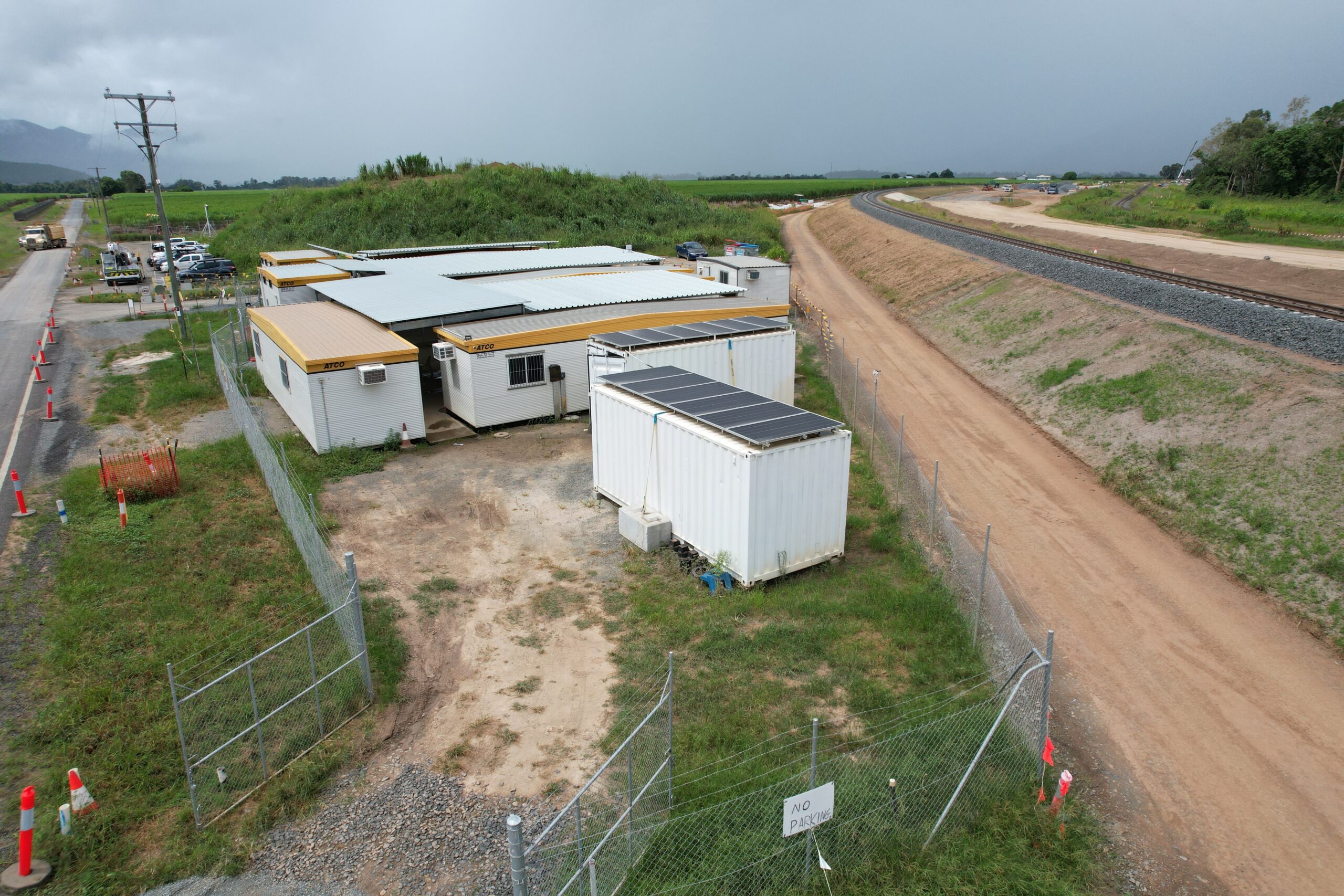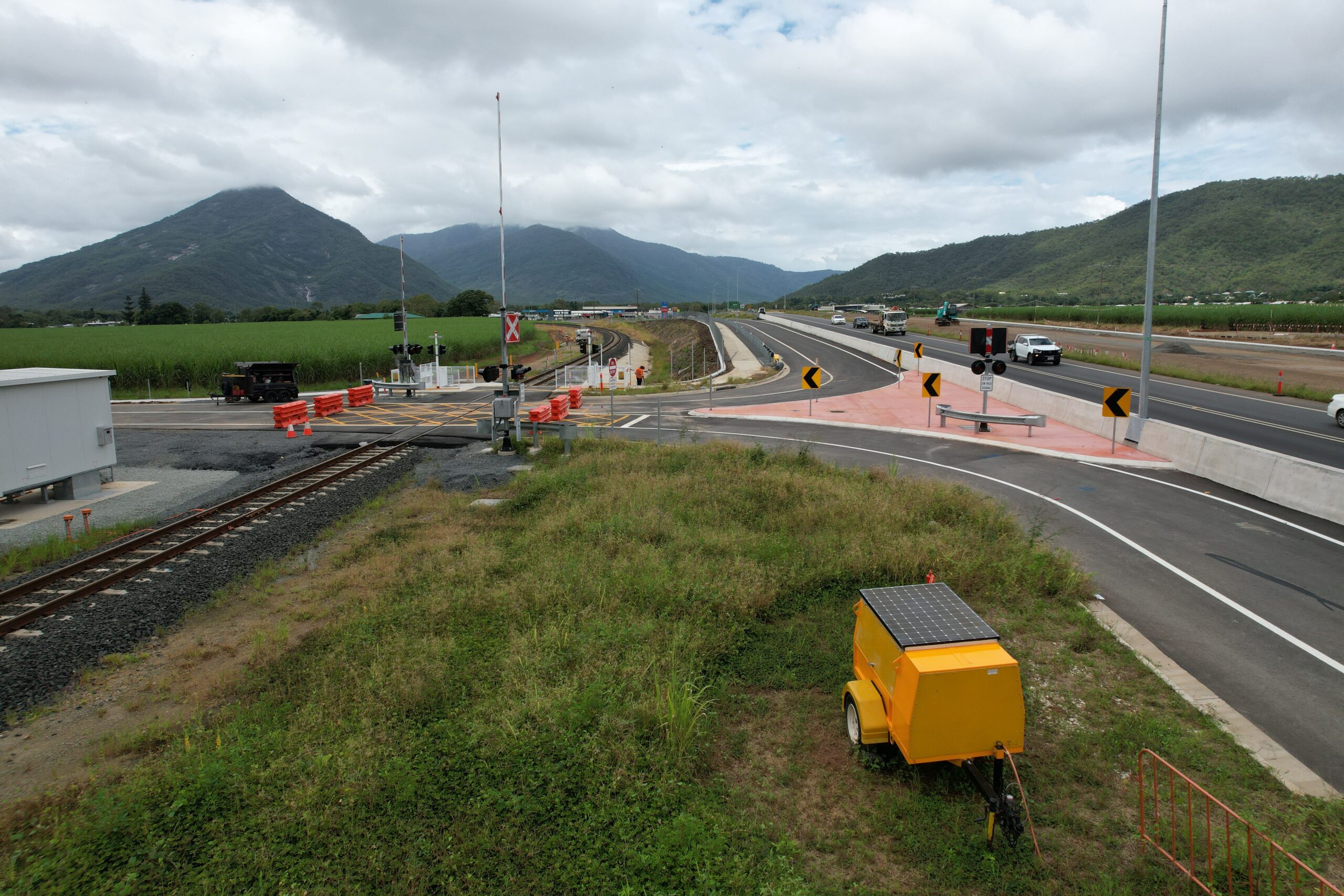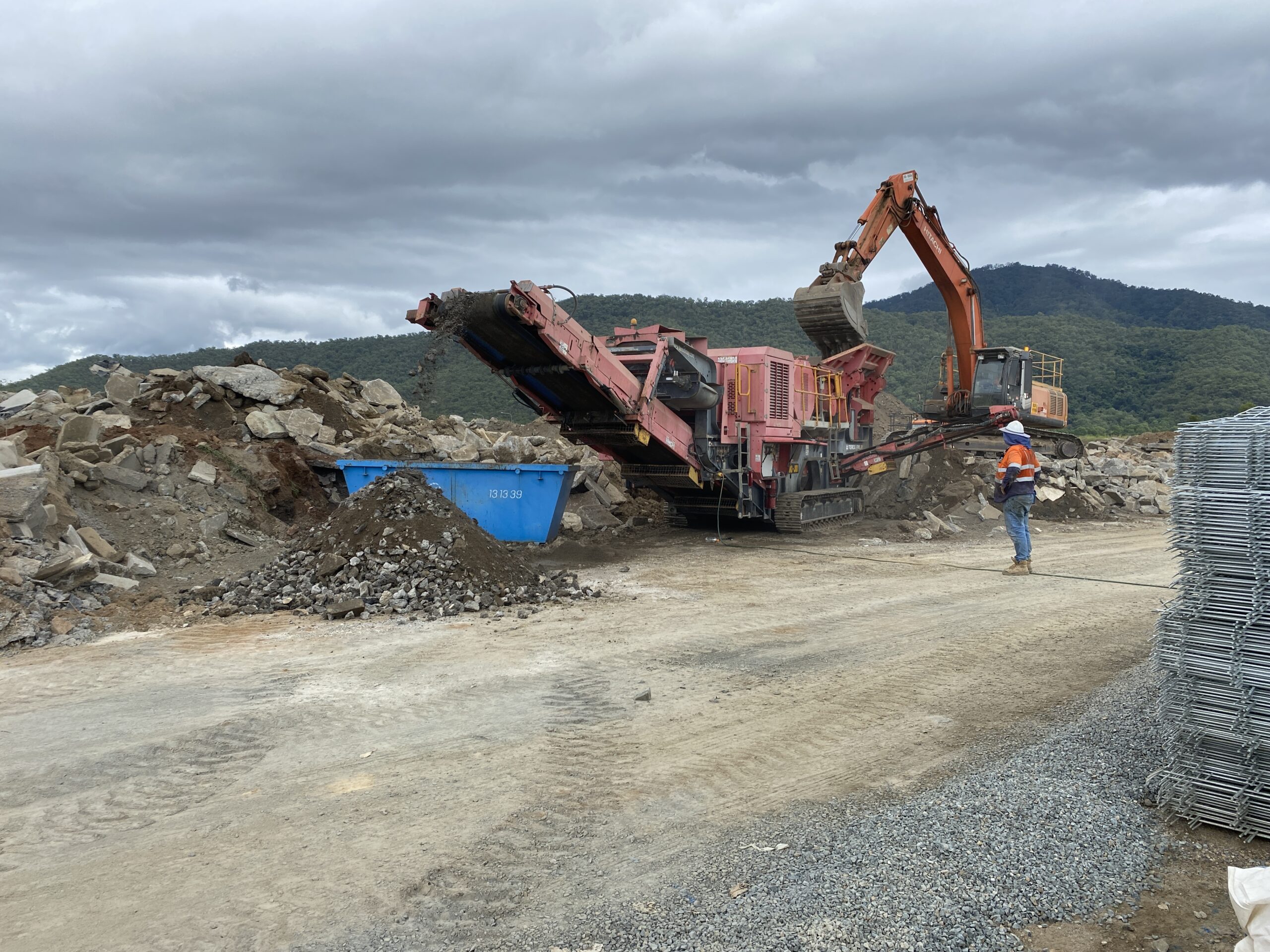Cairns Southern Access Corridor Stage 3: Edmonton to Gordonvale Project – Environmental Outcomes
Describe WHAT you have done and HOW you have done it.
Addressing climate change requires immediate and innovative efforts to reduce carbon emissions, supporting net-zero and fostering the circular economy. The extensive use of plant equipment in
construction poses challenges to emissions reduction, demanding creative approaches in material selection and construction methodology. The E2G project has tackled these challenges by implementing carbon reduction initiatives, focusing on inventive construction methods, materials, and energy solutions to drive towards net-zero and achieve circular economy outcomes.
The first initiative involved constructing over 10 km of concrete pavements for cycleways, footpaths, and shared paths using a Concrete Extruding Slipform Paver with a custom mould and a 100% recycled plastic fibre reinforcement product called EMesh. This Australian-first method was developed by E2G in conjunction with the project's concrete supplier, Emesh’s manufacturer and TMR and resulted in a reduction of raw materials consumption, significantly increased productivity, enhanced personnel safety, and supported waste repurposing. The slipform paver was used to mechanically place the concrete during pavement construction, reducing project construction times and lowering GHG footprints.
The E-Mesh product aligns with circular economy principles, repurposing waste into new products, diverting waste from landfills, and strengthening the market for sustainable materials. The project also supported employment opportunities for individuals on the National Disability Insurance Scheme (NDIS) through EMesh packaging.
In addition to the E-Mesh initiative, E2G worked with a Cairns local off-grid supplier where six solar hybrid systems were developed and deployed to replace traditional generators across the project in a state-first initiative. The innovation consisted of three containerised solar hybrid systems to power remote compounds and three trailer-mounted relocatable solar hybrid systems providing temporary power to utilities. These systems significantly reduced diesel usage while providing reliable 24-hour power to the site at a significant cost saving to the project. Each system is powered by a battery bank and fitted with solar panels that maintain the battery charge, with a backup generator running during peak usage periods.
The containerised systems powering the compounds observed benefits of an over 75% reduction in diesel usage and associated greenhouse gas (GHG) emissions, saving approximately 10,000L of diesel per year per unit, and providing 24-hour reliable power.
Additional project benefits included increased security through additional CPTED equipment (cameras and security lights) and the ability to use amenities and fridges overnight. This allowed the
workforce to store food , access hot water, hot drinks and ice machines at the start of the workday and significantly reduce noise impacts on nearby residential sensitive receivers.
The trailer-mounted relocatable solar hybrid systems providing temporary power to utilities observed benefits of an over 80% reduction in diesel usage and associated costs and GHG emissions, saving approximately 9,000L of diesel per year per unit, and a reduction in runtime to less than two hours every other night.
Other initiatives implemented on E2G include using recycled glass bedding sand sourced from the local council’s container recycle scheme and the onsite crushing and reuse of project generated
waste concrete.
What were the OUTCOMES and how were those outcomes shared?
The E2G project's carbon reduction initiatives led to numerous tangible and measurable outcomes that support the industry's drive for net zero and a circular economy. The outcomes include carbon reduction, cost savings, productivity improvements, and repurposing of waste.
Outcomes achieved on E2G through these initiatives include:
- Increased productivity ̶ combining E-Mesh with a slip form paver enabled increased productivity, with the project observing an increase from a maximum of 250 m2/ day to a maximum of 1050 m2/ day of shared path construction. The reduced duration of works has flow on benefits that reduce the duration of impacts on surrounding residential sensitive receivers.
- Reduced CO2 emissions ̶ the integrated approach led to a substantial reduction in CO2 emissions when compared to conventional methods, with the E-Mesh via a paver reducing combined material and fuel emissions by 50% and the solar hybrid systems reducing diesel usage and associated emissions by over 75% respectively. It is calculated that these initiatives have reduced emissions on E2G by approximately 1,400 t CO2-e.
- Cost savings ̶ the use of E-Mesh reinforced concrete extruded via a slipform paver resulted in an estimated reduction of approximately $12/m2 compared to traditional form-reo pour concrete pavement construction, translating to an overall cost reduction of about 25%. The solar hybrid systems reduced fuel usage and associated costs by over 75%, achieving a net break- even point of 18 months and cost savings beyond that point.
- Reduced fuel usage ̶ the adoption of solar hybrid systems resulted in a significant decrease in fuel consumption, with the containerised systems saving around 75% or ≈10,000L of diesel per year per unit and trailer-mounted systems saving 80% or ≈9,000L per year per unit. The E-Mesh Paver methodology resulted in a fuel saving of around 85% or ≈73,000L versus conventional methods.
- Circular economy benefits ̶ the E2G project demonstrated a commitment to the circular economy by repurposing waste into new products, diverting waste from landfill, and reducing raw materials consumption in construction, replacing 115,178kg of steel reinforcement with recycled plastic.
- Employment opportunities ̶ The project supported employment opportunities for individuals on the NDIS through the preparation of E-Mesh for the supplier, with around 18 hours of NDIS labour expended for every 100m3 poured of concrete comprising EMesh. By the completion of the project E2G will have supported over 850 hours of NDIS labour.
- Onsite Recycled Concrete Waste Reuse ̶ the project utilised a crusher to process and reuse concrete waste generated on site to reduce the volume of virgin materials required to be supplied to the project. To date approximately 27,000 T of concrete waste has been reused on site.
- Recycled Glass Sand ̶ the project is using locally produced recycled glass as bedding sand in place of virgin quarried sand, manufactured from recycled bottles collected from recycling bins and the container refund scheme. This has proven to be a cost-effective replacement for virgin sand. To date, the E2G project has utilised more than 2250 tonnes of recycled glass.
The outcomes of the E2G project were extensively shared across the joint venture, which resulted in the adoption of E-Mesh and solar hybrid systems in other projects, including LXRP projects in
Melbourne, the Gateway Project in Sydney and the Department of Transport and Main Roads (TMR) projects in Queensland. Both innovations have been verified by the Infrastructure Sustainability Council (ISC) , with the slipform machine construction methodology being an Australian first innovation, and the solar hybrid systems being a Queensland-first. ISC will communicate the innovations through their innovation system. E2G has also completed detailed case studies to support these innovation claims and assist other projects with implementation that have been disseminated among the project partners and within TMR. Presentations have been hosted for the project partners and TMR is developing a training module to share knowledge and lessons learned for these initiatives. Formal communications both within TMR, and externally through presentations and social media, have been rolled out to share the information within the wider industry and generate interest in sustainability in the public. In addition to this, presentations are planned for late 2023 at industry conferences including IECA and Engineers Australia.
Describe WHO benefited from your initiative, innovation, or approach?
The carbon reduction initiatives of the E2G project have brought measurable benefits to a wide range of stakeholders, including the construction workforce, project stakeholders, local communities, the broader construction industry, and local businesses.
The construction workforce has experienced improved working conditions due to 24-hour power, reduced noise pollution and emissions resulting from the solar hybrid systems deployed at all
satellite construction compounds. The decrease in reliance on traditional generators has led to a safer and more sustainable work environment.
Project stakeholders, including TMR and joint venture have reduced costs and increased efficiency due to the innovative construction techniques. These initiatives have provided a competitive
advantage and helped E2G set the standard for the region in sustainable practices.
Local communities have benefited from the reduced carbon emissions, noise impacts, and the adoption of environmentally friendly practices. The use of solar hybrid systems and more efficient
construction techniques has reduced the environmental impact of projects on surrounding communities through faster completion of works and reduction in generator noise.
The broader industry has gained valuable insights and inspiration from both the development of E2G project's E-Mesh Paver methodology and the solar hybrid systems. These approaches have
demonstrated the potential for sustainable practices and have encouraged the adoption of similar processes on other projects.
Local businesses have also benefited from the implementation of these initiatives. The deployment of solar hybrid systems has allowed a local business to carry out research and development on offgrid power in the construction industry with minimal financial outlay. This has increased the business's financial sustainability through the diversification of products, as the contractor has
constructed additional systems for further construction projects based on the lessons learned from E2G.
The approach to waste management and recycling has had significant implications. By utilising a crusher to process and reuse on-site concrete waste and using recycled glass sand instead of
virgin quarried sand, the project has reduced the need for virgin materials. This approach has, in turn, benefitted local waste recycling by providing a market for recycled materials. It supports the
projects and TMR’s sustainability policies by demonstrating successful waste recycling and repurposing in large-scale projects.
The E2G project has supported employment opportunities for individuals on the NDIS through EMesh packaging. This initiative has fostered social inclusion by providing meaningful work opportunities for people with disabilities and demonstrates E2G’s commitment to diversity and inclusion in the workforce.
What LEGACY and UN SDG CONTRIBUTION was achieved?
The legacy of these initiatives has encouraged the adoption of similar sustainable practices across other projects, driving net zero and circular economy outcomes. These innovations have
demonstrated the feasibility, cost-effectiveness, and environmental benefits of adopting renewable energy and a circular economy approach, while also setting a precedent for future projects to follow. These innovations have contributed to significant progress in achieving several United Nations Sustainable Development Goals (UN SDGs) within the infrastructure construction industry.
- SDG 7 ̶ Affordable and clean energy and SDG 13 ̶ Climate action
The solar hybrid systems increase access to affordable, reliable, and sustainable energy sources by reducing diesel usage and promoting renewable energy alternatives. This reduces the overall carbon footprint of construction projects and contributes to a sustainable energy mix. By implementing solar hybrid systems using E-Mesh, a 100% recycled product and the adoption of on-site waste reuse the project has helped reduce greenhouse gas emissions, contributing to global efforts to combat climate change and mitigate its impacts. - SDG 8 ̶ Decent work and economic growth
Both the solar hybrid systems and the E2G project support the creation of work opportunities and foster economic growth by promoting sustainable practices an innovative solutions. The deployment of solar hybrid systems in off-grid construction projects contributes to the growth of the renewable energy sector, generating new job opportunities and stimulating investment in clean energy technologies. In addition, the E2G project supports employment opportunities for individuals on the NDIS, fostering social inclusion and contributing to a more inclusive and equitable job market. - SDG 9 ̶ Industry, innovation, and infrastructure
Through the deployment of the solar hybrid systems and the development of new construction methods the E2G project encourages sustainable and resilient infrastructure design and construction. Both initiatives demonstrate how cutting-edge technology and processes can allow a project to be more efficient and environmentally conscious without compromising cost or project timelines. - SDG 11 ̶ Sustainable cities and communities
The solar hybrid systems and the E2G project's use of recycled materials contributes to the development of sustainable cities and communities by reducing the environmental impact of
urbanisation. The solar hybrid systems offer a more sustainable power solution for construction projects, minimizing greenhouse gas emissions, air pollution, and noise pollution associated with traditional diesel generators. The E2G project reduces waste and minimizes the environmental impact of new infrastructure projects through the use of recycled materials. - SDG 12 ̶ Responsible consumption and production
The solar hybrid systems and the reuse of site generated waste supports a shift towards more responsible consumption and production patterns. The solar hybrid systems reduce diesel consumption and promote renewable energy, while the new footpath methodology demonstrates the potential for repurposing waste materials in construction, reducing GHG emissions, and promoting a circular economy. Together they contribute to reducing waste and promoting energy efficiency throughout the entire lifecycle of construction projects.
By showcasing the economic benefits of adopting innovative technology and processes, such as the solar hybrid systems and the use of EMesh in a paver, both initiatives encourage companies in the engineering and construction industry to invest in sustainable solutions. This in turn stimulates economic growth by driving demand for new technologies, products, and services that support
sustainable development and create new markets. As a result, these initiatives not only contribute to the achievement of the UN SDGs but also serve as examples for other industry players to follow. By incorporating these sustainable practices and innovations into their own projects, companies can actively contribute to global efforts to combat climate change, promote sustainable development, and create lasting, positive environmental outcomes.
[embed]https://youtu.be/oo-ajzdHBeQ[/embed]






